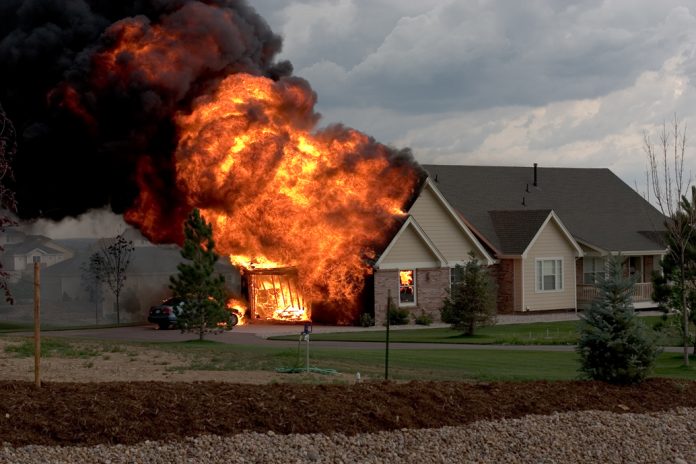It starts by identifying the most common causes
Fire is scary. Its ability to spread quickly is not to be taken for granted. You can’t take chances when it comes to such potential danger. It puts lives a risk, and even when a blaze is smaller and contained the result can still cause thousands of dollars’ worth of damage. You should always be protected with proper insurance especially if you live in a straw bale house. You have to do everything in your power to prevent any circumstances that could be responsible for such an occurrence. Fires may be of electrical or chemical origin, and common household items can be instantly combustible. So, let’s identify the risks and lower the chances of a fire (and protect us all in the process). It’s problem solving of the highest order…
The most common causes of a blaze are cooking fires. Obviously grease is extremely flammable and once it gets going those flames are hard to put out. If you are cooking with grease never leave the kitchen unattended, keep your eye on it always. Many fires were caused this way; a homeowner step out and returns to face a situation that’s out of control. The same applies to a burning stove, don’t leave it alone and be extra preventive by ensuring that all of your cookware is properly cleaned (this is to prevent gradual grease accumulation).

The next common factors in these situations are home heaters. Ones that run on fuel, like kerosene, can be of high risk. They might ignite or explode without proper care. Even electric space heaters can be hazardous, especially if there’s faulty electrical wiring. Keep cloth and fabrics (like clothes or blankets) away from heaters at all times and never leave the house when a heater is running.
It’s a dying trend by all accounts, but smoking is still a factor in a great number of house fires. It’s a habit that’s hazardous to your health but it can be extremely dangerous to others as well. We all have heard the horror stories of people smoking in bed. All it takes is a single lit ash to ignite the surface  of a mattress or a sheet, blanket, etc…. do yourself a favor – if you smoke, NEVER do it indoors. Never mind all the risk of second hand smoke to everyone else in the vicinity, or the nauseating odors, you could affect them immediately and much more directly by starting a fire.
of a mattress or a sheet, blanket, etc…. do yourself a favor – if you smoke, NEVER do it indoors. Never mind all the risk of second hand smoke to everyone else in the vicinity, or the nauseating odors, you could affect them immediately and much more directly by starting a fire.
Sure, you can’t have a romantic evening without candles. But they too can be very dangerous if left unattended. If one were to fall over, or if the flame came too close to something nearby, a fire could start immediately. The same thing could happen by leaving lighters and matches around for children to play with. Keep your flame devices completely out of the way so they don’t even tempt the inquisitive nature of children. And of course, if you have candles burning, always extinguish them when leaving the room.
We’ve mentioned faulty wiring previously; it’s a serious matter when it comes to electrical fires. Plugging in an electrical device that is somehow damaged could spark and lead to a fire. Your outlet could become overloaded with similarly tragic results. Never plug more power into a circuit than it is designed to handle. If you live in an older house it’s a good idea to have it inspected by an electrician.

Also, be mindful of chemical fires. When motor oil, cleaning fluids and other flammable liquids become extremely hot they are likely to explode. And, it’s not these chemicals only that need to be protected. Vapors can be very dangerous. Rags soaked in flammable liquids can spontaneously combust in great heat. Be certain all of your chemicals are stored properly in the intended containers and put them in areas that are of consistently even temperature, never getting too hot. Dispose of those oily rags with care, or wash them thoroughly.
Sadly, often a time of great joy can become one of sorrow. During the holidays Christmas trees are involved in a great number of house fires each year. Real trees dry out soon after being harvested, making it essentially flammable. All it would take is a hot light to get the brittle trees smoking. And if a spark ignites, that tree will be engulfed in seconds. Fake trees, meanwhile, are safer but you still risk an electrical fire from the twisted light cords that wind around them. Whether real or fake don’t leave a lit tree unattended.
 You need to be on top of the potential dangers in your home. Keep flammable goods stored properly and heat sources accompanied. Keep up on your general cleaning. A minor mistake on your part could cause a great catastrophe, so research your home (access its design software if possible) and learn all of the potential; hazards in order to keep it fully under control and safe from harm.
You need to be on top of the potential dangers in your home. Keep flammable goods stored properly and heat sources accompanied. Keep up on your general cleaning. A minor mistake on your part could cause a great catastrophe, so research your home (access its design software if possible) and learn all of the potential; hazards in order to keep it fully under control and safe from harm.








